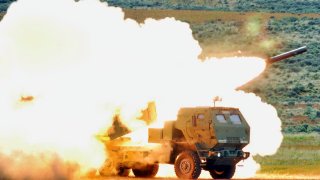Mykola Hryckowian

Assistance to Ukraine has become a sticking point in Congress, with no aid package expected until later this year. Both Speaker Mike Johnson and Senate Majority Leader Chuck Schumer have clearly stated that supporting Ukraine is in the U.S. interest. But one of Congress’ main complaints is that the Biden administration has not articulated a strategy for Ukrainian victory.
That’s a fair criticism. It is evident that the Russo-Ukraine War has become one of attrition. So, besides sending much-needed military aid (such as ATACMS, F-16s, and munitions), more is needed to help end the war and create a lasting peace.
Here, a robust and sustainable Ukrainian defense industry is critical. Historical examples include Israel, South Korea, and Turkey, each of which has a solid domestic defense manufacturing sector that satisfies its security needs and contributes to the security of its allies. Ukraine can achieve this with U.S. and European cooperation in reviving its defense sector.
Ukraine is no stranger to defense manufacturing and has many current and former successes in the field. The country was a major high-tech weapons designer and producer for the USSR, and several of these legacy enterprises have successful systems used today in the war (among them the Neptune anti-ship missile, the Stugna ATGM, and the Vilkh MLRS). Since 2014, the Ukrainian private defense sector has taken off and, in cooperation with state-owned enterprises, has developed and is supplying new weaponry to the front, such as the Bohdan Self-propelled Howitzer. The private sector has become innovative in developing AI, UAVs, unmanned sea drones, and robotic combat systems that have proven pivotal in battle. Recently, Ukroboronprom, Ukraine’s state arms producer, announced initiatives to mass-produce long-range kamikaze drones, another key technology used in the current conflict. Since 2014, the industry has also self-organized into several manufacturing associations, such as the Association of Ukrainian Defense Manufacturers (AUDM) and the National Association of Ukrainian Defense Industries (NAUDI).
But despite Minister of Strategic Industries Olexandr Kamyshin’s desire for Ukraine to become a defense manufacturing hub, mass production of these Ukrainian weapons is not yet as robust as needed. For Ukraine to have a sustainable defense industry, there needs to be direct investment in Ukrainian enterprises and the construction of hardened manufacturing facilities in the West of the country, away from the front.
Germany and Turkey are currently pursuing this strategy. Despite the risks posed by investing and manufacturing in a country at war, German arms conglomerate Rheinmetall has announced it will maintain and produce weapons in Ukraine. So has Turkish drone manufacturer Baykar, which will be co-producing the Bayraktyar and Acini UAVs using Ukrainian-made engines.
Glaringly absent from these activities, however, are U.S. defense firms. Despite the fact that the United States is the largest supplier of weapons to Ukraine, American defense companies have not been present in the revitalized Ukrainian defense sector—until recently. Last December, the Biden administration appears to have woken up to this shortfall and hosted the inaugural U.S.-Ukraine Industrial Base Conference.
This constitutes an excellent first step. It should be followed by other government initiatives designed to strengthen Ukraine’s defense-industrial base. There are several vehicles to do so, among them the Pentagon’s Ukraine Security Assistance Initiative, Foreign Military Financing (FMF), the $300 billion in frozen Russian assets now escrowed in the West, and the U.S. Agency for International Development.
The Russo-Ukraine War has painfully demonstrated that full-scale, high-intensity war is not a thing of the past. It has also made clear that existing estimates of weaponry in the West are woefully inadequate. Stockpiles must be replenished, and new manufacturing capacity must be brought online in Eastern Europe. Unless the war leads to the overthrow of the current Russian regime, the likelihood of future wars in Eastern Europe is high. It is in the U.S. strategic interest to ensure Ukraine wins this war and that Ukraine and the eastern front of NATO are ready for the next one. Beefing up Ukrainian industrial potential should be a natural part of this preparation.
No comments:
Post a Comment